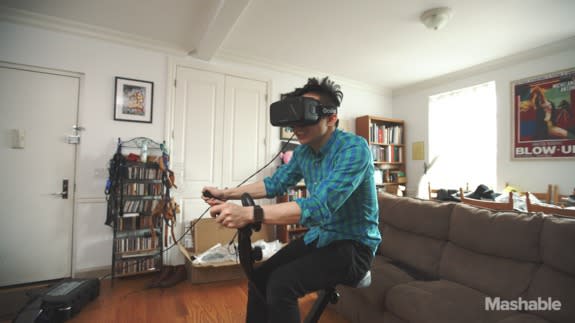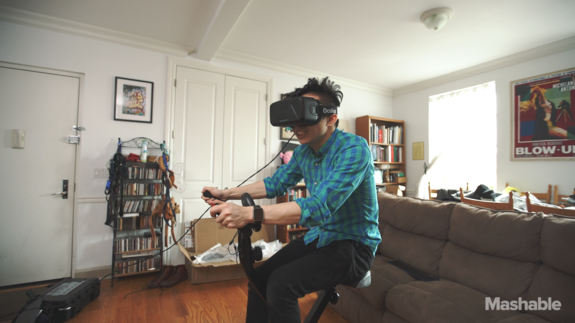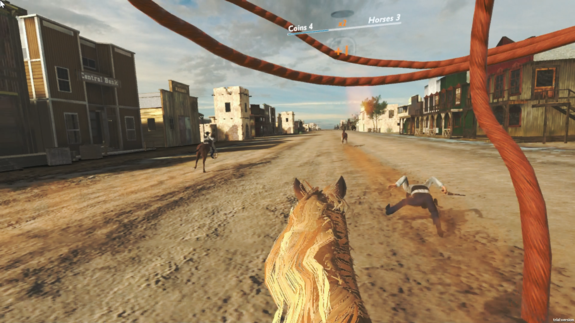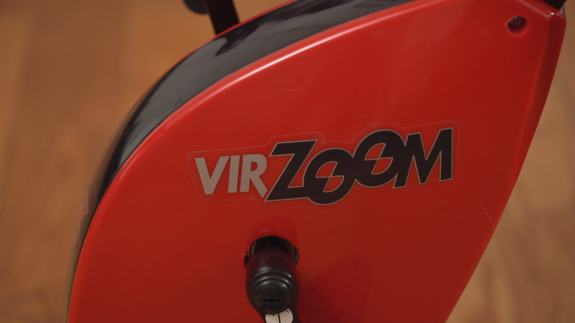I got sick pedaling this virtual reality fitness bike

Video: Rill Causey, Noah Throop
The three major VR headsets — the Oculus Rift, HTC Vive and PlayStation VR — are finally launching as finished consumer-ready products this year. VR headsets won't be mere prototypes for much longer. VR is finally really happening.
But as spectacular and immersive as virtual worlds are when you put on these headsets, there's still one looming question that VR has yet to answer: How will you control things in the virtual world in a convincing and realistic way?
See also: 8 hidden features every Samsung Galaxy phone user should know
Oculus Rift is betting on its Oculus Touch controllers that mimic your hands' movements, the Vive has its own pair of wand-like controllers and Sony's probably going to stick to a traditional PlayStation 4 gamepad or utilize its PlayStation Move motion controllers as we've seen in demo units.
Wilder controller ideas involve VR treadmills (a terrible idea if you ask me), motion-tracking gloves and exercise bikes. One such oddball is the VirZoom VR bike controller. I tried it out at E3 last year when it was still a bunch of sensors hooked up to a real bicycle. Now I've played with a near-final version, and I've got mixed feelings about it.

Image: Noah Throop/Mashable
First, let me just say I rarely work out. I've got a fast metabolism and I've been skinny my entire life. I live in New York City so I'm also used to walking everywhere; every week I walk 20 minutes to one very specific grocery store and then back with my hands full of bags. I take the stairs over the elevator whenever I can and I rarely spend any time driving in a car.
I'm the last person who needs an excuse to get up and be more active. Being active is already my life, not a New Year's resolution.
As such, I didn't care much for the exercising aspect of the VirZoom as much as I did the entertainment part. I wanted to find out if pedaling to control a video game would have a place in VR's future or not.
Getting set up
Let's start with the VirZoom bike itself. Regrettably, the VirZoom is not a sleek piece of hardware that looks like it's from the future — it's a generic-looking exercise bike. (I found one on Amazon that looks just like it.) It's ugly, but functional.
I tested out the alpha build of the bike, which is missing a bunch of buttons on the handlebars and a pair of triggers that will be present on the final version. The alpha bike only had a green and red button — one on each handlebar. The buttons felt great, like the A and B buttons on an NES controller, but I can't say for sure if they'll be the same ones on the final model.

Image: Noah Throop/Mashable
Since my review unit wasn't the final version, it didn't come with an instruction manual. There aren't a ton of steps to putting it together, but I still had to Google an image of the VirZoom and figure out where the seat, pedals, and handlebar went. There was an Allen wrench included, but it would have taken forever to build the VirZoom with it; I used my own adjustable wrench instead.
After building the bike, all I needed to do was connect it to a VR headset. I used an Oculus Rift DK2 (Developer Kit 2), but the VirZoom will also work with the PlayStation VR and HTC Vive. After installing the Virzoom software onto an old, upgraded Alienware X51 gaming PC, connecting the Rift to it, and plugging in a wireless USB dongle (to communicate with the bike), I hopped on and prepared to pedal my way through VR.
I immediately ran into calibration issues between the headset and the camera. It took another ten minutes of fiddling around with the camera's position before I started playing any games. The entire setup process only reminded how cumbersome VR was going to be for a lot of first-timers.
Made me sick real fast
While the software I tried was far from finalized — there's a new build every Friday — I did get a sense of what to expect while using the VIrZoom. At E3, I only got to try out one demo: Pegaso, a game that turned me into a jockey riding a winged horse.
With my test unit, I had time to play two other games: Stampede and Go Fast Car. In Stampede, you're a cowboy riding through a Wild West town and you have to lasso other cowboys off their horses, and in Go Fast Car, you are a dog (yes, a dog, as ludicrous as that sounds) driving an F1 race car around a track.
In all the games, the faster you pedal, the faster your horse or your race car will go. It might seem odd that you're pedaling to simulate a horse galloping or a car's wheels, but it felt quite natural to me. At no point did it feel strange.

Image: Virzoom
The games themselves aren't exactly deep — they're more like mini games — and the graphics are terribly outdated, but they were still really entertaining, to say the least. In a game like Stampede, I could turn my head in all directions and see enemy cowboys coming up my sides. To lock onto a cowboy, you press and hold one of the buttons on the handle bar and then release it. A few times, I wanted to swing my hands in the air and use an imaginary rope to lasso the cowboys or shoot them with a finger gun; one day we'll have Kinect-style hand and body tracking for VR and it'll be awesome.
Go Fast Car revealed how much more work the games needed. It was also the quickest to make me feel nauseous. The sense of speed from pedaling and speeding along the virtual track was so intense, I got dizzy, my stomach hurt and my eyes dried up. I didn't last for more than two minutes before I yanked the headset off and took a long breather on the sofa. Not only did the game make me sick to my stomach, but it was also beyond buggy. Mashable video producer Rill Causey tried it out and somehow pedaled off the course's track and ended up in a glitchy bizarro world.

Image: VirZoom
Pegaso also made me want to hurl rather quickly. As soon as my winged horse picked up air and I tried to maneuver up and down, my stomach cramped up and my lungs shut down. Go Fast Car made me sick while grounded, but Pegaso gave me vertigo.
The consumer release of the VirZoom will come with these three games and two more (and they'll all support online multiplayer), but the company has yet to confirm what those will be. I just hope these games are more polished and the company can figure out how to make them less dizzying. While there's no surefire way to make the VirZoom less nauseating, I think the best bet is to ease the player very slowly into the pedaling. Even users who think they're resistant to motion sickness shouldn't overdo it in the beginning.
There's a dial on the bike you can turn to adjust the tension of the pedals, so you can feel more burn in your thighs and legs, but I never felt the need to crank it up. Like I said, I'm not a hardcore fitness junkie.
Biking IRL is better in every way

I have a lot of respect for companies like VirZoom that are trying to combine video games and fitness with new technologies. It worked for Nintendo with the Wii Fit (and to a lesser extent the Wii itself), and it worked for Microsoft with Dance Central and the Kinect. So why not for VR?
As I said earlier, the model I reviewed was not the finished version. But even without the final hardware, finished games, the heart-rate sensor, workout modes and more advanced fitness-tracking stats that will be available in the final release, I got the sense that the VirZoom was little more than a novelty.
Sure, I easily broke a sweat pedaling on the VirZoom and I had some good times lassoing cowboys, but I never felt like I was completely blown away by it all. The included games provided a decent amount of fun, but they weren't engrossing the way even simple demos like the 3D painting demo I tried with the HTC Vive was.
After I packed the VirZoom up, I never felt the urge to take it out again. It's the same with a regular exercise bike. It's great the first couple of times you use it, but then it ends up in your closet collecting dust.
All of this doesn't even take into account how much it costs to get VirZoom up and running: $400 for the bike and another $1,500 for the Oculus Rift and compatible PC. We don't know how much the Vive or PlayStation VR will cost, but going by my setup, it cost at least $2,000.
I don't know about you, but that's a big chunk of cash to blow on feeling like you're flying on a horse or driving a race car as a dog. If you ask me, you're better off buying a real bike for a lot less and going biking in real life. You'll be able to explore new places, get some fresh air and still feel the burn in your legs.
VirZoom VR fitness bicycle
The Good
Stampede is fun • Adjustable tension dial
The Bad
Expensive • Generic fitness bike design • Not the easiest setup process • Games can make you nauseous
The Bottom Line
The VirZoom exercise bike for virtual reality headsets is little more than a novelty.
BONUS: Prynt Case makes Harry Potter's moving photos a reality
Video: Rill Causey, Quincy Ledbetter

 Yahoo News
Yahoo News 
